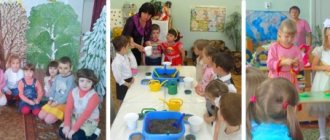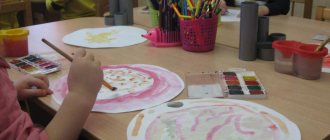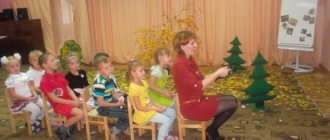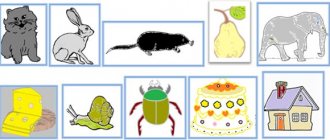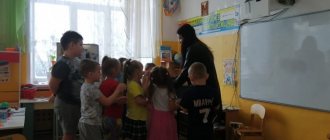Speech development. Topic: “Modes of transport” (preparatory group)
Transcript
1 Speech development Topic: “Modes of transport” (preparatory group) Purpose of the lesson: to consolidate knowledge about various types of transport. Tasks: Teacher Nazina Irina Leonidovna 1. Activate children's vocabulary with words and names of vehicles; the names of the professions of the people managing these funds. 2. Improve the ability to write descriptive stories about different types of transport. Exercise children in coordinating words in a sentence, in highlighting the first sound in words. 3. To consolidate the formation of such general concepts as “water transport”, “air transport”, “land transport”; differentiate them into “passenger”, “cargo” and “special transport”. 4. Develop cognitive interest in various types of transport. 5. Foster a sense of responsibility on the road. Progress of the lesson - V. You will find out the topic of our lesson if you answer, what is the name of everything that moves in space: drives, swims, flies and at the same time transports people and cargo? (Transport) -V. Let's remember what kind of transport it is? (ground, water, air, underground, city, passenger, cargo, special, magic). -IN. Today, guys, we will talk about different types of transport and find out how much you know about them. First, let's do a warm-up. Let's check how attentive you are. I will name different vehicles, if I'm wrong, you clap your hands. A boat, a train, a plane, And a bus, and a trolleybus, And of course, a pilot! D/I “Make no mistake”
2 Liner, boat, helicopter, motorcycle, machine gun, dump truck and plane! Electric train, truck, barge, match, SUV! Fuel truck, garbage truck, water truck, milk truck, dust truck, cement truck! -IN. Well done. Everyone was attentive. Sit down on the chairs. In front of the children, pictures are hung on the board with images of different vehicles by type: water, air, land transport. -IN. What type of transport is this? (water) Why is it called that? (floats on water). Name what relates to water transport (children's answers). Who controls the watercraft? (captain). Similar questions are asked regarding air and ground transport. -IN. Take a geometric figure each and divide into three groups. Now you will divide all vehicles according to purpose: passenger, cargo and special transport. Task “Passenger, cargo, special” Children complete tasks in subgroups. 1st receives the symbol “passengers”; 2nd symbol “cargo”; The 3rd receives the symbol “Ministry of Emergency Situations”. Next, each subgroup names “their” vehicles and explains their choice. -IN. Well done, you completed the task. Sit down on the chairs. Guys, who wants to talk about any vehicle according to plan: what it is called, what parts it consists of, where it moves, what it is used for, who drives it. The rest will listen carefully and if you remember any interesting information, then add to the story. Compiling descriptive stories about different vehicles (2-3 people). -IN. Let's remember what a machine can do. Stand in a circle. You will pass the ball to each other. Only the one with the ball answers. D/I “Choose an action.”
3 The car can: drive, brake, carry cargo, accelerate, go around potholes, drive off a bridge, drive into a garage, overtake, drive up to a house. (the rest of the children are given the task of naming what can be done with the car). A car can be: bought, washed, sold, filled with gasoline, donated, made at a factory, drawn, painted. Q. Guys, do you think it’s possible to determine the type of transport by sound? (Yes). Shall we play? (Yes). Now you must depict the type of transport whose sound you will hear. Outdoor game “Sea, sky, road, rails.” The sound of the sea: children imitate a ship (arms stretch forward, form a triangle with the apex forward, sway as if on the waves). The rumble of an airplane: children pretend to be an airplane (“flying” in different directions without bumping into each other). The sound of carriage wheels: children stand one after another, pretending to be train carriages, and move rhythmically in one direction. The sound of a running car engine: children pretend to drive a car (“driving” in the indicated direction). -IN. Well done! We rode on different types of transport. You know, the animals also wanted to ride, but they just couldn’t decide who would ride what. Shall we help them? (Yes) Sit down at the tables (children are given individual cards with pictures of animals and different vehicles). Today animals are in a hurry to visit, they all want to go by transport. In order to select transport for animals, the first sound only needs to be recognized in the word. — B. Look carefully at what is shown in the picture. Your task is to connect with a line an animal and a vehicle whose name begins with the same sound as the name of the animal. Children complete the task independently. The sheets of paper depict the Did/game “Who will ride what?” animals: elephant, horse, panda, mouse, cow, camel; vehicles: helicopter, dump truck, train, boat, boat, motorcycle.
4 -B. Did everyone complete the task? Now switch with your neighbor and check for mistakes. Well done! Did/game “Bending the words.” -IN. Who did we take for a ride? (Elephant, panda, horse, mouse, camel, cow). Who did we help? (Elephant, panda, horse, mouse, camel, cow). Who did we care about? (About an elephant, about a panda, about a horse, about a mouse, about a camel, about a cow). Who are we admiring? (Elephant, panda, horse, mouse, camel, cow). — V. Well done, you completed the task. Physical education lesson Exercises for coordinating speech with the movement “We’re going, we’re going by car” -V. imagine that you got out of the car you were just driving and started walking. What can we call you now? (pedestrians). Now imagine that you got on a bus. What can we call you now? (passengers). What pedestrians, drivers and passengers should know to avoid dangerous situations on the roads (traffic rules). Do you know how to behave in transport? (Yes). Let's check it now. You need to add just one word: “is it allowed or prohibited” - playing and jumping at the bus stop - talking loudly on the bus - giving up your seat to older people - leaning out of the window - behaving calmly on the bus - pushing everyone aside, shouting - distracting the driver - being naughty on the road, disturb people - be an exemplary pedestrian. Did. game "Allowed is prohibited." -IN. Well done! What we talked about today in class. (Children's answers)
5 - Q. To avoid dangerous situations on the roads, you and I will continue to study the rules of the road.
Topic: Transport
Goal: to generalize and systematize the idea of transport, to activate the vocabulary on this topic, the practical use of prefixed verbs and compiling a short descriptive story using questions.
Program content:
Developmental task: Teach children to generalize, classify vehicles: cargo, passenger, fine motor skills, coordination of speech with movement, visual attention and perception.
Educational speech tasks: compose a descriptive story about this transport toy using questions:
- practice the practical use of words with affectionate and magnifying connotations;
- practical use of prefixed verbs;
- agree nouns with adjectives in number, gender, case;
- learn to compose a whole from parts (cut pictures).
Corrective task: to train children in the use of feminine and masculine nouns; expand your vocabulary on the topic “transport”.
Educational task: to teach children through game images the rules of behavior in public transport.
Materials: toys transport, pictures of transport, cut-out pictures of transport, audio recording “Bus”, panorama of the city with images of transport.
Progress of the lesson
— Guys, how did you get to kindergarten today, who lives far away, what? (On foot, car, bus)
- Those who live next to the kindergarten came on foot, those who live far from the kindergarten - went by bus, car, taxi (the teacher places the corresponding pictures on the magnetic board). What is a car, a bus, a taxi? (Transport)
— What are the people who travel in passenger transport called? (Passengers)
— What is the name of the machine that helps transport cargo? (Cargo)
— What kind of cargo can trucks transport (Furniture, sand, snow, food, gasoline, milk, etc.)
Pay attention to the panorama of the city, consider the image of transport. Finger game “Let’s count.”
We will bend our fingers - (clench and unclench our fingers) We will name transport: Car, taxi, Tram, metro, bus (unclench our fingers, starting with the little finger) We clenched 5 fingers into a fist, named 5 types of transport. (clench your fingers into a fist, starting with the thumb).
— Who drives passenger and cargo transport (driver, driver).
Generalization from the teacher: Cars are our helpers, but without a driver they cannot work. The driver must know well the structure of his car and its parts.
- Do you know what main parts it consists of?
— What is the name of that part of the car where the driver sits and controls the car? (Cabin)
—Where do they put the cargo? (Body)
— Where do the passengers sit? (Salon)
— Without which part will the car never move? (Without wheel)
Game exercise “Riding on the bus”
“Now let’s all take a ride on the bus together.” Who will we be on the bus? (Passengers). How should passengers behave on the bus and why?
I will speak, and you answer:
— The bus from the stop ( departed ), to another stop ( arrived ). Then he climbed a small hill ( drove in or drove over ) and together with us he bridged ( moved over ). He quickly entered the tunnel ( drove ) and from there soon to a gas station ( went, arrived ).
Speech game “At a gas station”
All the cars in order arrive at the gas station. (with both hands “turn the steering wheel” in front of you) A fuel truck, a garbage truck, a milk truck with milk, a grain truck with fresh bread, and a heavy timber truck.
(Fingers alternately, starting with the little finger, touch the palm).
Having refueled, the bus went to the exhibition-salon ( arrived, stopped ).
— An exhibition-salon of vehicles “Funny Motors” opened in our group. I will be the director, and you will be the car sales managers. You must tell us about the transport you like and advertise it:
Car name.
What is she like: describe her appearance, color.
Name the parts.
What is it intended for?
— I’ll start with advertising: This is a bus. He is red. It has a cabin, wheels, many windows, doors. The bus carries passengers.
Listen to 3-4 stories.
- Guys, in the distant fairy-tale country of “Liliput” there live little people and everything they have is small: clothes, shoes, and transport.
Game exercise “Big-small”
| Educator | Children |
| car | machine |
| automobile | car |
| truck | truck |
| tram | tram |
| trolleybus | trolleybus |
| bus | bus |
Cars are our faithful and reliable assistants. But in order for them to serve for a long time, they need to be looked after, repaired, and placed in the garage.
Didactic game “Fix the car”
The drivers pressed hard on the pedals, the car fell apart into parts. Help, help, assemble a car from parts.
Children assemble cars piece by piece (from cut-out pictures). At the end they say what they did.
And now I’m turning you into a machine, whoever wants what kind. And each of you will leave the lesson with your own signal. Verbal game “Pretend to honk your car’s horn” (honk your horn loudly for goodbye, honk quietly for the cars to drive far away).
